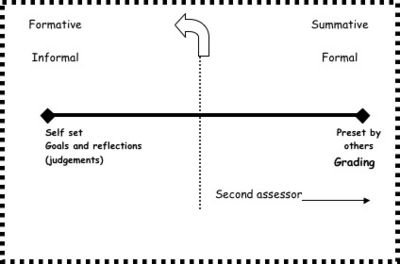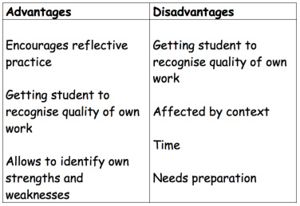Student role
Student Role in Assessment
This module explores both the challenges and the advantages of using student self assessment and student peer assessment.
Learning outcomes for this module
Participants will:
- Have knowledge of student self assessment and student peer assessment as a strategy
- Be aware of ways in which student self assessment and peer assessment can most appropriately be used
- Have ideas of how self assessment and peer assessment can enhance student learning in their own areas/context.
Student Self Assessment
Let's start with your own previous experience
Use these thoughts as a starting point for exploring student self assessment. |
Purposes and principles
What is it?
Self assessment is the student’s ability to evaluate and reflect on their own learning, making a judgement as to their progress and how they could improve.
Assessment is a power process
- Do you agree with this statement or not?
- Who holds the power – lecturer or student?
- What are the advantages in holding that power?
If you consider the assessment spectrum as a continuum self assessment can be used across the spectrum but the approach differs.
Self Assessment Continuum
The following quotes separate self assessment (which can range across the continuum) from self grading (which tends to sit at the more formal end of the continuum.
“self assessment involves the use of evaluative processes in which judgement is involved”
“self grading is the marking of ones own work against a set of criteria and potential outcomes provided by a third person, usually a tutor”
- Brown & Knight, (1994)
Key Thoughts
- Self assessment does not just occur – it requires training and development.
- It is an unrealistic expectation for students to automatically self assess.
- Start small and build on this
Why would you use self assessment?
Below is a table created by a workshop group considering the advantages and disadvantages of using self assessment.
Student involvement in self assessment can result in the following
- Changes role of student from passive to active
- Focus on learning rather than product
- Enables deeper learning – “look more deeply at things they have done” (Race & Brown, 1993, p.96)
- Development of self-evaluative skills to improve own learning ability thus resulting in more effective learning (learning spiral)
- Encourages development of ‘autonomous learners’ rather than ‘passive dependence’ on lecturer (Brown & Knight, 1994, p52).
- Encourages greater ownership in the work undertaken
- Increased motivation
- Prepares more adequately for the work/employment environment
- Encourages students to focus on their achievements and areas in need of development
- Supports lifelong learning
Self assessment sits more appropriately at the formative end of assessment spectrum but can be used summatively with careful preparation and sound negotiated criteria.
How you can use self assessment
Self assessment is more than assessing match between criteria and performance – it means “negotiating and establishing appropriate criteria in the first place” (Brown & Knight, 1994, p54).
Generation of own criteria results in greater ownership therefore increased learning
Setting Assessment Criteria
Assessment criteria must relate to the learning outcomes
| Try setting your own self assessment criteria for this specific module.
Go back to the learning outcomes at the start of this module and write down criteria that would help you to define how you would assess your own learning for this.
Are there situations with your own teaching that you might encourage students to set their own assessment criteria?
|
Lecturer’s moderation role
It is important if grading occurs for the lecturer to provide a moderation role
Ensure as a lecturer you know the criteria very well and be comfortable with what defines each grade
Don’t allow yourself to be bullied by the student.
Assessment methods suitable for self assessment
Back to some brainstorming.
A workshop group identified a range of situations where self assessment could be incorporated:
- Application of peer assessment
- Team work assignments
- Quality control when making product
- Group critique sessions
- Practical skills
- OSCE and marking maths – procedural learning
- Role play
Compare those to suggestions by Glasgow and Hicks (2003)
- Journaling can be used to encourage review of performance over a period of time
- Participation in evaluative discussions with peers or lecturers
- What would you consider you did especially well?
- What would you now do differently?
- Portfolios
- Poster work (assess self performance but content material is shared with peers)
- Practical or skill self assessment – student needs to be able to justify and give rationale for grade given.
- Universal self questions (Glasgow and Hicks, 2003)
Tips
Brown & Knight, (1994, p57), suggest that a successful way of students being able to evaluate their own work is to see examples of good, poor and average work from other students.
If lecturer provides feedback on the ‘quality of the self assessment’ this improves learning re self evaluation thus supports the learning spiral.
Potential pitfalls and considerations
Students can often be resistant due to
- No previous experience
- Lack of self confidence and not able to make such important judgements on their own work
- Believing it is abdication of duty on the lecturer’s part
Fear of students over-rating themselves, (Race & Brown, 1993, p.96) – research indicates there is no clear pattern to this (Brown & Knight, 1994, p54).
Students are reliable in self assessment as long as safeguards are in place – (Boud, also Gibbs cited in Moon, 2002, p123).
Workbusting
From a work busting angle – self assessment requires more time initially to set up but there are potential advantages longer term
- If used within summative marking, the lecturer could take on moderation role which is less time consuming than marking from scratch
Student Peer Assessment
Peer assessment provides another tool in the range of assessments that can be used; as all methods of assessment can disadvantage some students (Brown, Race and Smith, 1996, p.26).
Students become the assessors of each others work.
This can be used for any assessment task (not only group assessment as commonly associated with).
- Attribution of marks
- Formative comment
- Or both
There is a continuum of responsibility in the peer assessment process from ticking items on pre-prepared protocols to developing assessment criteria relevant to the stated learning outcomes and marking (Moon, 2002, p122).
Purpose & principles
Peer assessment can assist in students gaining a better understanding of the subject matter (see it through others eyes) also better understanding of assessment process (eg. report writing). (Brown & Knight, 1994, p61)
It can strengthen learners’ skills at self assessment and also complement self assessment – useful in terms of developing professional skills
When others are involved it can become less boring – encourages greater commitment and involvement (Brown, Race and Smith, 1996, p.26).
Work-busting
In small groups students can review each others written drafts and correct minor errors and add comments – tutor then can moderate comments which means time is spent on macro issues rather than minor errors (Brown & Knight, 1994)
Once it is set up well, there is the potential to save lecturer time in marking or providing feedback (Moon, 2002, p123)
Strong lecturer/facilitator role is required in terms of moderation
Fears and Pitfalls
Consider the impact of peer assessment.
| List the advantages and disadvantages of peer assessment that you have experienced.
Then consider these suggestions. Minimise the feeling of risk for the students by making it a small percentage of overall course mark (Race & Brown, 1993, p.94) But at the same time make the peer assessment marks meaningful – it should count for something (Brown, Race and Smith, 1996, p.115).
|
Potential problems
- Fear over reliability of student marking – research demonstrates not proven to be true – no consistency in research outcomes - (Brown & Knight, 1994, p61)
- Students may want to settle old scores and give others low marks
- Through friendship and loyalty give higher marks than warranted
- Student collusion – pre arranged agreed marks
- Peers may make unsophisticated and unfair judgements eg. Extroverts get higher marks than quiet consistent contributors
- Can become a nightmare if there are multiple assessors – keep it simple
Assessment methods suitable for peer assessment
- Student Presentations
- Seminars – Presentations
- Whenever students present to peers they are always subject to informal evaluation (Habeshaw, Gibbs, & Habeshaw. 1998, p167).
- Reports
- Essays and reports can be used for peer evaluation if the conditions are appropriate (Race & Brown, 1993, p.94)
- Essay Plans
- Calculations
- Interviews
- Annotated Bibliographies
- Practical Work
- Practical skills – peer assessment of practical skills can be less threatening that assessment by authority figure (Brown, Race and Smith, 1996, p.69).
- Poster Displays
- Posters
- Questions on how well the brief/outcomes are met
- How effectively it has been portrayed
- How visually effective a poster is
- All help shape the learning process
- Peer assessment with posters provides added advantage of being able to learn from research of whole class rather than just their own (Brown, Race and Smith, 1996, p.62).
- Portfolios
- Exhibitions and Artifacts
Process
For peer assessment to be valid it is necessary to ensure that in each case, evidence and criteria are taken into account (Brown & Knight, 1994, p59)
The clarity and objectivity of the assessment criteria will determine the success of the peer assessment – words such as interesting, stimulating, coherent and well structured require further descriptive detail to be well understood within a group (Race & Brown, 1993, p.94)
Prepare students well for this assessment process to help overcome potential negativity (Race & Brown, 1993, p.94)
Useful to involve students in giving peer feedback as safe intro to peer assessment process
Can also provide mark free rehearsal opportunities – ideal for interim (formative) feedback (Brown, Race and Smith, 1996, p.114).
Alternatively as a learning exercise assess work from a previous group (with names deleted) (Brown, Race and Smith, 1996, p.23).
Regularly reinforce rationale for using peer assessment (Brown, Race and Smith, 1996, p.114).
Keep assessment criteria to a minimum (Race & Brown, 1993, p.95).
Allow plenty of time for peer assessment as they are not as experienced at this process (Brown, Race and Smith, 1996, p.115).
Useful to prepare marking sheet in form of a grid, allows for easy calculation of marks that can be averaged across a group (Race & Brown, 1993, p.95).
Review of marking scheme enables students to learn from experience and improve next time (Habeshaw, Gibbs, & Habeshaw. 1998, p168).
- - sense of ongoing development and learning
For it to be more useful as a learning tool then needs students to devise own marking scheme – work on agreed list of criteria (Habeshaw, Gibbs, & Habeshaw. 1998, p167).
Significant benefit is the quantity of feedback the student receives – if the tutor/lecturer acts as another group member then student receives benefit of both ‘abundant feedback’ and ‘authoritative feedback’ (Race & Brown, 1993, p.95).
Safeguards include marking on the spot and handing in marking sheets to prevent collusion (Habeshaw, Gibbs, & Habeshaw. 1998, p168).
Moderation of marks by lecturer is required to ensure fairness and provide further opportunities to those who might feel aggrieved by the process (Brown, Race and Smith, 1996, p. 115).
Putting peer assessment into action
Explore the potential in relation to your own area
References
- Brown, S., & Knight, P. (1994). Assessing learners in higher education. London: Kogan Page.
- Brown, S., Race, P., & Smith, B. (1996). 500 tips on assessment. London: Kogan Page.
- Glasgow, N, A., & Hicks, C.D. (2003). What successful teachers do: 91 research based classroom strategies for new and veteran teachers. California: Corwin Press.
- Habeshaw,S., Gibbs, G., & Habeshaw, T. (1998). 53 Interesting ways to assess your students. Bristol, U.K: Technical and Educational Services Ltd.
- Moon, J. (2002). The module and programme development handbook: A practical guide to linking levels, learning outcomes and assessment. London: Kogan Page.
- Race, P., & Brown, S. (1993). 500 Tips for tutors. London: Kogan Page.



